Working in at Akwa Pro Tackle, it’s easy to see the build up to the barra opening, especially in the enthusiasm of the local fishers, and this season is set to be a good one if we get some decent rain.
Opinions have changed dramatically over the last three to four years of research as to what the big girls need for a spawn to be successful, and even without a wet last year there was still a small percentage of barra that had the opportunity to spawn.
The science says they need a very specific dilution of runoff and salt water, as the catalyst for a good spawn, so here’s hoping for a great wet. Locations that will attract and concentrate barra are baitfish buffets, and tributaries that have links to inland billabongs and lagoons will distribute their bounty as the wet swells them to flooding levels and the landlocked bait heads downstream to run the gauntlet of bucket mouths.
For shore-based anglers, this is the time of year that offers the best opportunity to catch big numbers of barra from land-based locations in the upper reaches, and flooded causeways, weirs and creek junctions.
The majority of sporting anglers regard this time of year as catch and release season, especially as many of the landlocked fish don’t fare too well on the table. Those that have resided in the fresh have a very easily distinguished colour, and don’t sport the chromed up sides and yellow tail of a high table quality salty barra.
There is nothing complicated about targeting barra during a wet. Casting hardbodies and plastics into likely locations is likely to be eaten by a barra as it gorges itself in an attempt to put body weight back on.
Most of the year sees fairly standardised barra practises used around rivers, drains and headlands, and some of these locations are extremely tide specific if you want any significant result. Some of the best fishing is had when certain locations are only inundated on the bigger tides. The baitfish try their hardest to push back in tree lines to escape the hunting predators. Areas that usually only get a meter or so of water over them during smaller runs, become bait gathering Meccas on the bigger tides and all sorts of predators follow them up sometimes only for a couple of hours while there’s sufficient water.
Both the run-in and run-out can be hot bite periods. Having a pair of top notch sunnies is absolutely imperative to identify the shade changes of both fish and snags. I use the Copper lens Tonics, and have found them to be the best.
As the water recedes from these flats, anglers have to get the timing right or risk being stranded for a tide cycle in sandfly and mozzie-infested areas exposed to the sun and elements. I generally fish with my son, and at only eight years old, the mentioned risks can be pretty dangerous for a kid, so I use my electric motor as an indicator of when to get the hell out of there. Once the leccy starts to chew sand or mud, we know it’s time to get ready to bail out.
For me, hardbodies are the best bet for flooded mangroves. The dirty waters that are sometimes part of bigger tides require a more strong actioned lure to be quickly locatable by a fish in the murk. I also find that the average size of barra is better on the hardbodies.
Visibility can be as little as a couple of inches, and it would be a reasonable assumption that an extra noisy rattle would be needed to get their attention, but I have never found this to be necessary. The hooks and split rings emit enough noise to get a response, but as they say, you use what you have confidence in, and if a rattling lure makes you feel confident then that’s important.
If you’re not comfortable with your lure, you won’t work it thoroughly and put all the finer details into the retrieve – you’ll just go through the motions.
The most important attribute of a hardbody in deep-flooded mangroves and snags is having the guts to withstand the required drag and extra thumb pressure to stop a decent fish in the sticks. Hooks, split rings and even body material all combine to hold up under some serious forces.
There are a couple of stand out hardbodies that these days, are in just about every barra anglers’ box, and the Halco 105 Hamma has quickly become one of those. The colour range is quite expansive, but I really only use a handful of these available, and are my ‘confidence’ colours. The gravy train, mullet, white with red head and lime green cover just about everything.
A couple of years ago Halco re-released the 120mm three hook Laser Pro, much to the joy of barra and jack anglers missing this important tool, and it was all due to public demand. Being of a smaller profile, it sometimes draws more strikes than the Hamma, depending on what the major food source is at the time. For instance, when you see small gar in reasonable numbers where you’re casting, then the Laser Pro is often more effective. When it’s the mullet getting attention the Hamma seems to be more appropriate.
The difference in retrieves varies between the two, and the old expression ‘bombering’ is descriptive of the constant twitching and tweaking necessary to get an appropriate action out of that lure. Mind you, it’s more of a generic term that describes the retrieve action required to get results, and for me, the Laser Pro’s design and body weight is the best there is for this particular twitching retrieve style. My three favourite colours in the LP range are the gold with black back, the mullet colour and the good old gravy train.
Whichever you decide on, it has to cast true, and if your lures gliding off on its own indiscriminate path, it’s going to be useless in tight cover, and this is the other reason I use those mentioned.
The impoundments may have been the initially been the home of the paddle-tails, but there is no doubt they are also here to stay for wild fish as well. Flicking treble armed lures way up into the back blocks of drowned mangroves and sunken timber can be frustrating at times, and in really tight timber can snag up on the first twitch.
If you don’t have a lure-retrieving pole, then some of these to be left hanging from the structure out of reach. At best, you’ll have to spook whatever fish are there to go and get your lure back. Rigged on a weedless hook, paddle-tails can be slid over branches and roots and then allowed to flutter down draw fish out from otherwise unreachable spots.
The strike rate can be a bit of a downside to the weedless rigs sometimes, but there is no denying the fact that when fish are tucked way back out of hardbody’s reach, the weedless paddle-tails fit the bill. Wider gaped hooks are best for the fat and deep body shads, but the slimmer gaped worm styles don’t allow enough exposure to find the mark once the bite is registered.
The pre-weighted hooks that have the lead moulded onto the shanks are the preferred models, such as the Atomic Seekers in the EWG, but close behind them is the Gamakatsu Wide Gape hooks that you can rig with a ball sinker in the loop knot.
Sinker size is gauged on the size and design of the chosen paddle-tail. It has to be heavy enough to get that all important tail working on the drop, and hold the nose down a little during the retrieve. If you’re fishing deeper structure or holes, then obviously this would require much more weight to reach the fish and hold it down against the current. In the snags however, as little as a no. 1 can be used to keep the nose down while adding enough stability during a retrieve and stop it from rolling over.
Lure size is determined by a few factors and it’s up to the angler to find the right size range for them. If you’re after nothing but big fish, then the massive models associated with the impoundments work well. These lures do require a solid rod to cast them and to set that hook.
On the other hand a 4-6” model that will comfortably fit a 6/0-8/0 hook will get more bites and rarely be passed up by barra of any size.
One little trick to ‘bling’ up your presentation is to dip the tail in Quick Coat Worm dip, which permanently changes the colour of the softie, and adds contrast in murkier waters.
As far as colours go, I’ve found the chartreuse to be better in the clearer waters and the red to be best in the dirtier stuff.
The fact is that when fish become focussed on one type of bait, that’s pretty much what you need to present in order to get the most action. Your bigger shads are attempting to imitate the mullet-sized bait, and the smaller and narrower designs are more like herring and other small baitfish, and then there are the prawn imitations.
There are plenty of prawn and shad or minnow imitations on the market, and I have tried most of them, but have settled on just a few that show consistency and durability.
In the prawn range the Atomic Prong is a real standout, and have flappy bits that activate under water pressure or speed. The 3” and 4” models cover just about all of our haunts and they double up as reef lollies for the trout.
If I need a smaller presentation when the jelly prawns are running, then the 3” is hard to beat, but most times the 4” Prong is the one that sails from my rod tip.
The main by-catch with the Prongs and other small plastics in the stick is jacks, and they can often outnumber the barra, which isn’t a bad thing, that’s for sure.
I tend to use the Prongs rigged weedless in the shallower snag strewn areas, but standard jigheads in the deeper snags, holes and rock bars. When the water temperature drops, I downsize considerably to the 3 1/4” Atomic Plazo Paddletail. I always have a 6lb outfit at the ready for when the smaller baits are the focus of the bigger fish, and it would surprise you how many decent barra fall for these tiny lures when the bait they are feeding on is small.
Fish over a meter long aren’t uncommon, and you’re in for a tussle when they decide to eat your lure on the light gear. Fish of 60-70cm are more common, and the by-catch is variety of predators from tarpon, cod, golden snapper (fingermark), grunter, queenfish, GTs, flathead, plus many more, and they can be a real surprise package.
I fish these minnows on traditional jigheads, and they are usually 1/3-1/4oz in the heavy gauge hook. To be honest, this is one of the best ways to teach someone how to use plastics as the bites are regular and the action more consistent.
The variations adaptable to all of the mentioned techniques, rigs and lure types is countless, and I have run out of room, but play around with what you feel confident with, and don’t feel foolish for trying something different.
I hope that this gives you a few more tricks to try out, and as with any new technique, the more you practice it the better you’re going to get at it, so get out on the water and let the fun begin.
February is the month where these silvery critters are back on the menu and the barra bug bites pretty hard across the north. If you haven’t caught a barra before and would like to tangle with one of these icons, these tips and tricks will work all up and downn the coast where barramundi exist.
Remember to be mindiful of size and bag limits if you intend to keep a few for the table.
Now’s the time to hit ‘em, so get casting!
Reads: 2971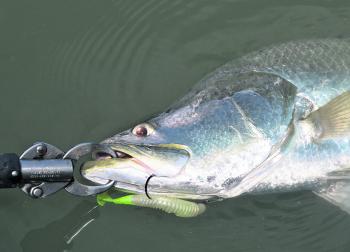
Similar to many paddle-tails, the Bassman COD Grubs are a winner, and I recently had a chance to trial some in the snags with great results.
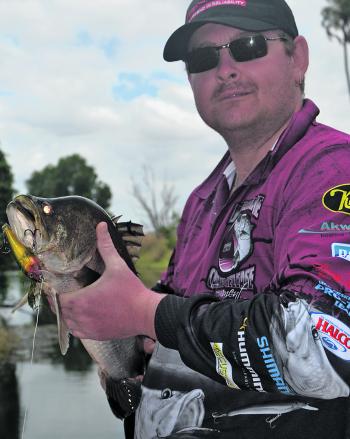
Danial Erskine, son of legendary fishing Godfather Jack Erskine, cradling a nice little freshwater barra that monstered a 105 Halco Hamma off the side of a weed bed in a Billabong.
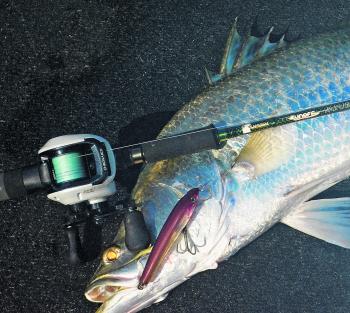
The 105 Halco Hamma in the gravy train colour scheme is one of those lures that just keeps on producing, and is one of my favourites when casting lures at bigger specimens, particularly around flooded mangroves on the flats and headlands.

Since the releasing of the Laser Pro 120 by Halco a couple of years ago, they have been embraced by barra anglers familiar with the older models. They're as good now as they were then, if not better. The one pictured has the hooks up sized with Gamakatsu’
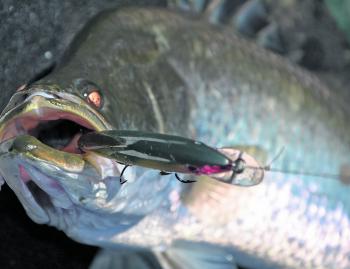
Shallow gar coloured Laser Pro 120s are a must on the flooded flats around mangrove roots and drains.
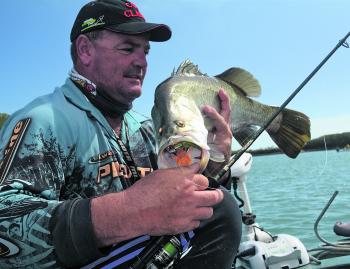
It may go against many theories, but if you know that there are barra in an area but they won't bite, try downsizing your lure. In this instance, we had cast a school for half an hour without even a bump. The first three casts with the 3 1/4” Atomic Plazo

Long-nosed pliers are essential for barra fishing, not only to remove the hooks from a deep hooked fish without damaging it, but also to keep your hands and fingers as far away from those pointy bits as possible.
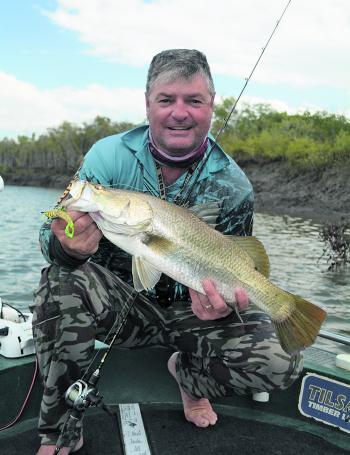
This little creek barra is only around 62cm, but is average for the creeks and drains. Any small piece of structure is worth a cast and the small snag in the background had several others holding off it on the run-out tide.
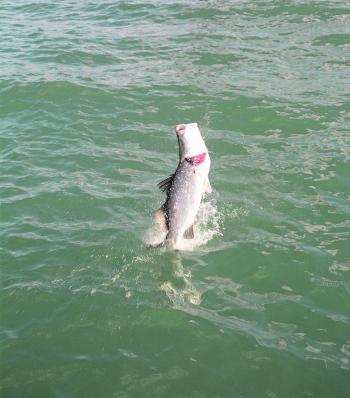
Airborne barra are renowned for throwing the hooks in mid air, and the aerial thrashing will straighten or throw an insufficient hook. Buy wisely, as even some of the expensive lures available will cost you fish after you've done everything else right.




